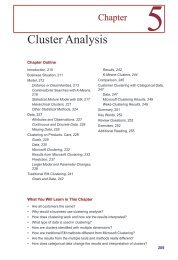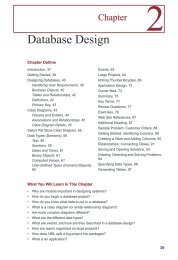Database Management Systems Appendix: Projects - Jerry Post
Database Management Systems Appendix: Projects - Jerry Post
Database Management Systems Appendix: Projects - Jerry Post
- No tags were found...
You also want an ePaper? Increase the reach of your titles
YUMPU automatically turns print PDFs into web optimized ePapers that Google loves.
Introduction to <strong>Database</strong> <strong>Projects</strong>To truly learn how to build business applications, you need to work on a databaseproject. The projects described in this appendix are generally simpler than real-life projectsbut complex enough to illustrate common problems that you will encounter.The projects are designed to be built throughout the term. Students shoulddemonstrate a completed database application at the end of the term. Preliminaryquestions or assignments are given for each project to get you started. However, the mostimportant aspect of the case is to build the final, complete application. To provideadditional feedback, the instructor should also evaluate the projects at two intermediatestages: (1) the list of normalized tables and (2) some initial forms and reports.The most important advice to the students is that you must begin work on theproject as soon as possible. Do not put the project off until the end of the semester. To haveany chance at completing the project, most students will have to put in 20 to 40 hours oftime. The project will reinforce the concepts discussed in the chapters—particularly datanormalization and application design. If you work on the project throughout the semester,you will gain a better understanding of the topics, and you will finish most of the projectbefore the end-of-term crunch.Class projects are slightly different from real-world applications, but they havemany features in common. One of the most challenging aspects is that any project containsa level of uncertainty and ambiguity. When you start a real-life project, you never knowexactly what the project is going to involve. As you talk with users, you encountercontradictions, uncertainty, and confusion over terms and goals. In real-life, you resolvethese problems through experience and discussions with managers. With class projects, youdo not have direct access to the managers and users. The instructor can answer somequestions, but students will need to make their own decisions and interpretations.When you first read the case, try to focus on the big picture. Identify theenvironment, goals, and objectives of the proposed system. You should take notes on thecompany and jot down additional questions. Additional research of the industry and similarfirms will help identify terms, goals, and potential problems. When you begin to analyze theindividual forms and reports, you need to identify the overall purpose of each form. Youshould be able to describe the purpose of each form in one sentence. Avoid using the form’stitle—describe its purpose in your own words. For any of the cases, you should make thislist and keep it handy so you always remember the overall purpose of the application.Remember that you will probably have to rework the normalization several timesbefore the project is complete. Remember that every time you change the primary keys, youfirst have to delete relationships. Try to develop a good normalized list before you begincreating forms and reports, but leave yourself enough time to go back and change the tablesif you find problems.In many cases it pays to start small and add tables and features slowly. Start withan initial set of tables and keys that you are certain are correct. Then begin building forms.Add columns and tables as you need them. If your initial tables are correct, you should beable to add new columns and tables without altering the existing design. For the finalproject, it is usually better to complete half a project where everything works, instead of alarge mess where nothing works.One final word of advice: back up your work. Always keep a backup copy of yourproject on a different disk. Two or three copies are even better. Disks are cheap.2







